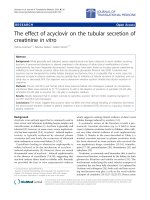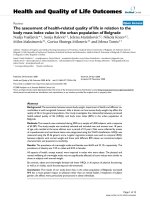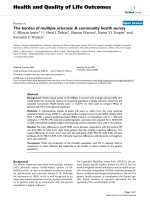Báo cáo hóa học: " The Fabrication of Nano-Particles in Aqueous Solution From Oxyfluoride Glass Ceramics by Thermal Induction and Corrosion Treatment" pdf
Bạn đang xem bản rút gọn của tài liệu. Xem và tải ngay bản đầy đủ của tài liệu tại đây (349.56 KB, 5 trang )
NANO EXPRESS
The Fabrication of Nano-Particles in Aqueous Solution From
Oxyfluoride Glass Ceramics by Thermal Induction and Corrosion
Treatment
Hua Yu Æ Nan Hu Æ Ya-Nan Wang Æ
Zi-Lan Wang Æ Zong-Song Gan Æ Li-Juan Zhao
Received: 6 July 2008 / Accepted: 3 October 2008 /Published online: 25 October 2008
Ó to the authors 2008
Abstract An innovative route is reported to fabricate
nano-particles in aqueous solution from oxyfluoride glass
by the thermal induction and corrosion treatment in this
letter. The investigations of X-ray diffraction and trans-
mission electron microscope based on nano-particles in
glass ceramics (GCs) and aqueous solution indicate that the
nano-particles formed in glass matrix during the thermal
induction process are released to aqueous solution and their
structure, shape and luminescent properties in glass host
can be kept. Owing to the designable composition of the
nano-particles during glass preparation process, the method
is a novel way to obtain nano-particles in aqueous solution
from GCs.
Keywords Nano-particles Á Glass ceramics Á
Thermal induction and corrosion treatment
Introduction
Since Wang and Ohwaki [1] reported that transparent
oxyfluoride glass ceramics (GCs) showed more efficient
upconversion (UC) from infrared to visible than fluoride
glass in 1993, many researchers have paid attention to
oxyfluoride GCs. [2–5] The advantages of these materials
are that the rare earth (RE) ions can be incorporated
selectively in the fluoride crystal phase with lower phonon
energy after thermal induction and the materials remain
transparent due to the nano-scale size of precipitated
crystals much smaller than the wavelength of visible light.
Unlike multiphoton absorption in organic dyes or
semiconductor quantum dots (QDs), photon UC involves
real intermediate quantum states to generate efficient vis-
ible light by near infrared (NIR) excitation. High-efficient
luminescent intensity, adjustable size, narrow size distri-
bution and unique optical properties are helpful to practical
applications of UC materials, especially RE-ion-doped
inorganic nano-particles after heat-treatment, in the fields
of flat-panel display, light-emitting diodes, temperature
sensors, biolabels, DNA detection, photodynamic therapy,
etc [6–10]. Moreover, different nano-particles composition
could be designed in glass matrix [11–14]. Unfortunately,
ever since the first report on oxyfluoride GCs, there have
been much research on the properties of nano-particles in
GCs but no publication has been reported about how to
obtain free nano-particles in aqueous solution from the
GC-host and how to apply it to the fields mentioned above,
especially in biological field. Therefore, it is of great sig-
nificance to develop convenient routes to fabricate
inorganic nano-particles doped RE-ion in aqueous solution
from GCs in order to meet their practical application
requirements.
Silicate oxyfluoride glass is selected here and
(Pb,Cd)F
2
:Er
3?
,Yb
3?
nano-particles were formed in glass
matrix after thermal induction. Acid corrosion treatment
was employed to remove the glass matrix in order to obtain
free (Pb,Cd)F
2
:Er
3?
,Yb
3?
nano-particles in aqueous
H. Yu (&) Á N. Hu Á Y N. Wang Á Z L. Wang Á Z S. Gan Á
L J. Zhao (&)
Photonics Center, College of Physical Science,
Nankai University, Tianjin 300071, China
e-mail:
L J. Zhao
e-mail:
H. Yu Á L J. Zhao
Tianjin Key Lab of Photonics Material and Technology for
Information Science and The Key Lab of Weak Light Nonlinear
Photonics, Ministry of Education, Nankai University,
Tianjin 300457, China
123
Nanoscale Res Lett (2008) 3:516–520
DOI 10.1007/s11671-008-9189-2
solution. The UC emissions of (Pb,Cd)F
2
:Er
3?
,Yb
3?
nano-
particles in aqueous solution have been well characterized
by pumping the intermediate
4
I
11/2
state of the Er
3?
ion via
a facile 980 nm NIR diode laser. The 980 nm excitation
wavelength is fairly transparent for most large biomole-
cules and does no damage to them. The UC emissions of
(Pb,Cd)F
2
:Er
3?
,Yb
3?
nano-particles in aqueous solution
are convenient to observe. Additionally, different nano-
particles composition and different RE-ion-dope can be
employed for cellular and intracellular target.
Experimental Details
Oxyfluoride glasses with composition of 45.5SiO
2
–
40PbF
2
–10CdF
2
–0.5Er
2
O
3
–4Yb
2
O
3
were prepared. About
20 g of starting material were fully mixed and melted in a
covered platinum crucible in air atmosphere at 1,000 °C
for 2 h, and then cast into a steel plate. [1–5] To obtain
nano-particles in glass ceramic, the glass samples were
subsequently heat-treated at 470 °C for 8 h at the nucle-
ation temperature measured by differential thermal
analysers (DTA). Using DTA equipment (TA-Inst 2100),
samples were held in a Pt crucible and analysed against a
calcined Al
2
O
3
reference at a heating rate of 20 °C
min
-1
.The nano-particles in aqueous solution were fab-
ricated with the following method. Firstly, the GCs (about
500 mg) were immersed into 5.65 mol/L hydrofluoric
acid for 20 h to get rid off silicate glass host. After
corrosion treatment, the nano-particles were deposited by
solid–liquid separation. Then pH value was adjusted to
neutrality by repeated adding distilled water. Finally, the
nano-particles in aqueous solution were dispersed using
sodium lauryl benzenesulphate. A small quantity of the
dried nano-particles powder was used for X-ray diffrac-
tion (XRD) measurements, while a dilute solution of the
dispersed powder in distilled water was used for fluores-
cent and shape studies. XRD analysis were performed to
identify the crystallization phase with a power diffrac-
tometer (D/Max-2500), using CuKa as the radiation. The
2h scan range was 5–85° with a step size of 0.02°.
Fluorescent spectra were measured with SPEX Fluorolog-
2 Spectrofluorimeter (with error ± 0.2 nm), in which
980 nm semiconductor laser is the excitation source and a
photo-multiplier tube is the detector. In order to compare
the intensity of the luminescence of all the samples as
accurately as possible, the position and power of the
pumping beam and the width of the slit to collect the
luminescence signal were fixed under the same condi-
tions. All the measurements were carried out at room
temperature. The preparation and measurement process
for all samples are the same conditions.
Results and Discussion
Figure 1a shows the XRD pattern of the investigated GCs.
After thermal induction, the XRD pattern of GCs presented
intense diffraction peaks, which can be easily assigned to
the b-(Pb,Cd)F
2
:Er
3?
,Yb
3?
phase [15]. The lattice constant
of b-PbF
2
crystal with the fluorite structure is
a = 0.575 nm. The slightly smaller lattice constant of the
present nano-particles may be interpreted by assuming that
the nano-particles are a b-PbF
2
solid solution in which
Pb
2?
ions with ionic radius of 0.129 nm are partially
substituted by Cd
2?
ions whose ionic radius is 0.097 nm
and RE-ion with ionic radius about 0.100 nm. [15]This
result is further supported by TEM of our glass-ceramics
shown in Fig. 1b. The micrograph reveals that nano-
particles are uniformly dispersed in a glass matrix. Fur-
thermore, the particle size distribution has been shown in
Fig. 1c. The average size of as-prepared nano-particles
determined from TEM image is 42.6 nm.
The nano-particles in aqueous solution were obtained by
hydrofluoric acid corrosion treatment, adjusting pH value
and dispersion of surface active agent. Figure 2 shows the
XRD spectrum and TEM image of nano-particles after
corrosion treatment process. Phase identification of the
nano-particles has been studied by using XRD. The typical
XRD patterns show strong diffraction peaks that can be
indexed to the b-(Pb,Cd)F
2
:Er
3?
,Yb
3?
phase due to the
appreciable shift of XRD peaks position and former
research results [15, 16]. No additional or intermediate
phase is detected in the sample. The peaks position and half
peak breadth of XRD are in concordance with those mea-
sured in GCs, which indicates that nano-particles are
released from glass matrix to aqueous solution. Moreover,
the baseline of XRD is nearly a straight line compared with
that of XRD of GCs, which also indicates that silicate glass
host is corroded completely. The Fig. 2b is the TEM image
of nano-particles in aqueous solution and Fig. 2c reveals
the size distribution. The average particle size is obtained
as 41.7 nm, which is very close to the former calculation
result of nano-particles existing in glass matrix 42.6 nm.
And the comparison of Figs. 1 and 2 indicates that the
nano-particles formed in glass matrix are released to
aqueous solution and their structure, shape and size dis-
tribution in glass host are kept well. The potential reason
could be the restriction of glass mesh structure during the
thermal induction process. The nano-particles exhibit a
narrow size distribution and display a good dispersibility in
aqueous solution.
Figure 3 reveals the main UC emission of the
2
H
11/2
/
4
S
3/2
/
4
F
9/2
?
4
I
15/2
transition in GCs and in aqueous
solution under 980 nm diode laser excitation. The weak
ultraviolet UC radiation of the
4
G
11/2
?
4
I
15/2
transition
were not shown here, since we focus on the ratio of red and
Nanoscale Res Lett (2008) 3:516–520 517
123
20 40 60 80
0
2000
4000
6000
*
*
*
*
*
*
*
*
Intensity(arb. units)
(111)
(200)
(220)
(311)
(222)
(400)
(331)
(420)
(422)
2θ (Degree)
*
(a)
(b)
Fig. 1 a XRD patterns of GCs
after thermal induction. The
asterisks correspond to JCPDS
file NO.06-0251 (b-PbF
2
). b
TEM micrographs of nano-
particles existing in glass
matrix. c .The size distribution
of nano-particles in glass matrix
20 40 60 80
0
4000
8000
12000
16000
*
*
*
*
*
*
*
*
*
Intensity(arb. units)
2θ (Degree)
(111)
(200)
(220)
(311)
(222)
(400)
(331)
(420)
(422)
(a)
Fig. 2 a XRD patterns of dried
nano-particles after corroding
treatment. The asterisks
correspond to JCPDS file
NO.06-0251 (b-PbF
2
). b TEM
micrographs of nano-particles,
showing highly dispersive nano-
scale quasi-sphere. c The size
distribution of nano-particles in
aqueous solution
518 Nanoscale Res Lett (2008) 3:516–520
123
green fluorescent intensities, which could show the varia-
tion of crystal lattice field around the RE-ion. Compared to
GCs, the red fluorescent intensity of nano-particles in
aqueous solution dramatically increases as shown in Fig. 3.
The UC mechanisms of the green and red emissions had
been researched by our groups [16, 17]. And the Er
3?
ion
can be promoted to the
4
I
11/2
state through ground state
absorption (GSA) of laser photons, and then to the
2
H
11/2
state by use of the excited state absorption (ESA) or energy
transfer UC (ETU) processes. The
4
S
3/2
state can also be
populated by relaxations from the upper
2
H
11/2
state. The
green luminescence is emitted by the transition from
2
H
11/2
and
4
S
3/2
state to
4
I
15/2
ground state. Hence, the green UC
luminescence seldom subjects to influence of phonon
energy difference of crystal field around the RE ions. The
red UC luminescence, however, comes from the phonon-
assisted quantum cutting (PQC) process and is primarily
generated in low phonon energy crystal lattice field [16]. It
is worthwhile to point out that luminescent signal includes
emission from RE ions in glass host and fluoride nano-
particles at luminescent spectra. In GCs, most of RE ions
are incorporated in the fluoride crystal phase, which mainly
emit red UC luminescence. Nevertheless, a part of RE ions
exists in glass host and mainly emits green UC lumines-
cence. As Fig. 3 shows, the ratio value of red and green UC
luminescent intensities increase from 1:1.31 in GCs to
1:0.61 in nano-particles aqueous solution. The key reason
for the red UC enhancement arises from the fact that the
glass host is corroded by hydrofluoric acid, the fluoride
nano-particles formerly embedded in glass matrix are
released to aqueous solution and eventually red UC lumi-
nescent intensities increase sharply. These results are
consistent with the conclusion drawn by XRD and TEM.
The nano-particles in aqueous solution have the same
luminescent properties as those existing in glass host.
From a practical point of view, it is possible for the
nano-particles in aqueous solution from the GC-host to
have a potential application as nano-sized probes used in
the drug targeting after appropriate modification during the
exploration of cellular and intracellular targeting. Under
ideal circumstances, nano-particles for site-specific drug
delivery, mediated by a targeting sequence, should deliver
their payload only to specific target cells, tissues or organs
[9, 18]. Moreover, nano-particles may optimize the bio-
availability and the bio-distribution of the drug. The nano-
particles in aqueous solution from the GC-host also apply
in non-invasive imaging by detecting the luminescence of
nano-particles inside biological systems, like cells, tissues
or whole organisms. The further work for digging out the
properties and applications of the nano-particles in aqueous
solution is under way.
Conclusion
In summary, b-(Pb,Cd)F
2
:Er
3?
,Yb
3?
nano-particles in
aqueous solution were prepared by means of thermal
induction to produce nano-particles in glass matrix and
corroding the glass host by hydrofluoric acid. The nano-
particles in aqueous solution have the same structure and
luminescent properties as nano-particles existing in glass
matrix. Although thermal induction and corrosion treat-
ment were used to prepare b-(Pb,Cd)F
2
:Er
3?
,Yb
3?
nano-
particles in aqueous solution in this letter, it may directly
apply to any other silicate GCs doped with other RE ions
and embedded various composition of nano-particles, since
the preparation method is based on a fundamental
consideration.
Acknowledgement The work is supported by the National Natural
Scientific Foundation of China under Grant No. 10574074, 973 Pro-
gram (No. 2007CB613403), the 111 Project (B07013), Changjiang
Scholars and Innovative Research Team in University, the Cultivation
Fund of the Key Scientific and Technical Innovation Project from the
Ministry of Education of China under Grant No. 704012, Key Inter-
national Science and technology Cooperation Project under award
No. 2005DFA10170, and National College Students Innovation
Project from the Ministry of Education of China under Grant
No. NK0713. The authors also thank Cui Guoxin (Suzhou Institute of
Nano-tech and Nano-bionics, Chinese Academy of Science) for many
helpful suggestions.
References
1. Y. Wang, J. Ohwaki, Appl. Phys. Lett. 63, 3268 (1993). doi:
10.1063/1.110170
2. W. Luo, Y. Wang, Y. Cheng, Y. Cheng, F. Bao, L. Zhou, Mater.
Sci. Eng. B 127, 218 (2006). doi:10.1016/j.mseb.2005.10.034
3. F. Lahoz, I.R. Martı
´
n, U.R. Rodrı
´
guez-Mendoza, I. Iparraguirre,
J. Azkargorta, A. Mendioroz, R. Balda, J. Ferna
´
ndez, V. Lavı
´
n,
Opt. Mater. 27, 1762 (2005). doi:10.1016/j.optmat.2004.11.047
500 550 600
650 700
0
500000
1000000
1500000
2000000
2500000
3000000
Wavelength (nm)
Intensity(arb. units)
glass ceramic
nano-particles in aqueous solution
Fig. 3 Measured UC red and green emission in GCs and nano-
particles in aqueous solution under diode laser excitation of 980 nm
Nanoscale Res Lett (2008) 3:516–520 519
123
4. M. Beggionra, I.M. Reaney, Appl. Phys. Lett. 83(3), 467 (2003).
doi:10.1063/1.1594842
5. J. Me
´
ndez-Ramos, V. Lavı
´
n, I.R. Martı
´
n, U.R. Rodrı
´
guez-Men-
doza, V.D. Rodrı
´
guez, A.D. Lozano-Gorrı
´
n, P. Nu
´
n
˜
ez, J. Appl.
Phys. 94(4), 2295 (2003). doi:10.1063/1.1592298
6. F. Liu, E. Ma, D.Q. Chen, Y.L. Yu, Y.S. Wang, J. Phys. Chem. B
110, 20843 (2006). doi:10.1021/jp063145m
7. S. Sivakumar, F.C.J.M. van Veggel, M. Raudsepp, J. Am. Chem.
Soc. 127, 12464 (2005). doi:10.1021/ja052583o
8. B. Dong, D.P. Liu, X.J. Wang, T. Yang, S.M. Miao, C.R. Li,
Appl. Phys. Lett. 90, 181117 (2007). doi:10.1063/1.2735955
9. D.A. Groneberg, M. Giersig, T. Welte, U. Pison, Curr. Drug
Targets 7, 643 (2006). doi:10.2174/138945006777435245
10. L.Y. Wang, Y.D. Li, Comput. Chem. Eng. 24, 2557 (2006)
11. L. Huang, T. Yamashita, R. Jose, Y. Arai, T. Suzuki, Y. Ohishi,
Appl. Phys. Lett. 90, 131116 (2007). doi:10.1063/1.2719028
12. D. Karmakar, S.K. Mandal, R.M. Kadam, P.L. Paulose, A.K.
Rajarajan, T.K. Nath, A.K. Das, I. Dasgupta, G.P. Das, Phys.
Rev. B 75, 144404 (2007). doi:10.1103/PhysRevB.75.144404
13. T.R. Oliveira, L. de S. Menezes, Cid B. de Arau
´
jo, A.A. Lipovskii,
Phys. Rev. B 76, 134207 (2007). doi:10.1103/PhysRevB.76.
134207
14. S. Bhattacharya, A. Ghosh, Phys. Rev. B 75, 092103 (2007). doi:
10.1103/PhysRevB.75.092103
15. H. Yu, L.J. Zhao, J. Meng, Q. Liang, X.Y. Yu, B.Q. Tang, J.J. Xu,
Chin. Phys. 14(9), 1799 (2005). doi:10.1088/1009-1963/14/9/019
16. H. Yu, L.J. Zhao, Q. Liang, J. Meng, X.Y. Yu, B.Q. Tang, L.Q.
Tang, J.J. Xu, Chin. Phys. Lett. 22(6), 1500 (2005). doi:10.1088/
0256-307X/22/6/056
17. H. Yu, L.J. Zhao, J. Meng, Q. Liang, X.Y. Yu, B.Q. Tang, J.J. Xu,
Chin. Opt. Lett. 3(8), 469 (2005)
18. A.M. Derfus, W.C.W. Chan, S.N. Bhatia, Adv. Mater. 16, 961
(2004). doi:10.1002/adma.200306111
520 Nanoscale Res Lett (2008) 3:516–520
123









